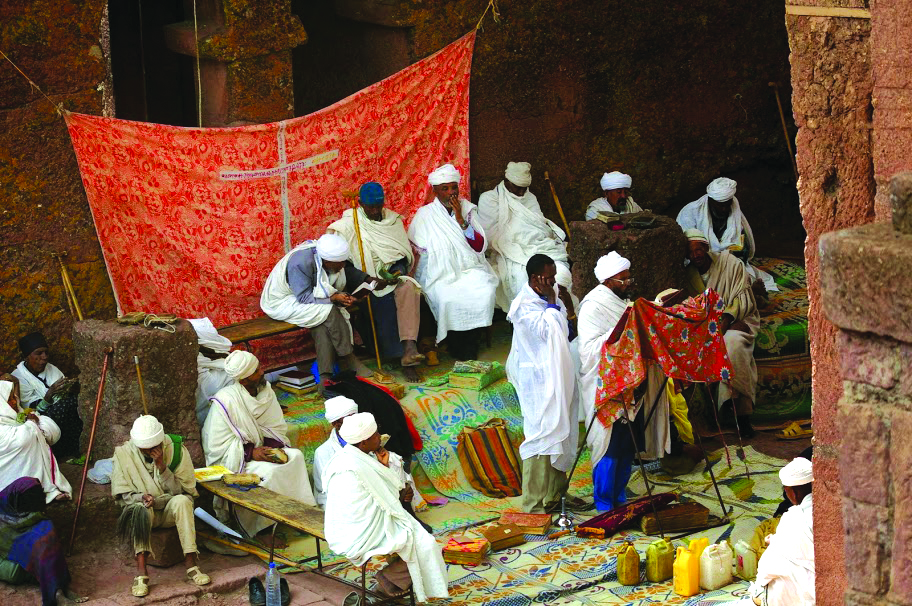Ethiopia boasts a kaleidoscope of cultures, from animistic tribes in the southern Rift Valley to its orthodox Christian heritage in the northern highlands. This ancient land offers both the intrepid traveler and religious pilgrim an opportunity to sample the variants of Abrahamic religions practised with unique zeal.
The Kingdom of Axum in what is present-day Ethiopia and Eritrea was one of the first Christian countries in the world, having officially adopted Christianity as the state religion in the fourth century. Ethiopia is mentioned over 37 times in King James’ version of the Bible. Today, Ethiopia continues to predominantly be Christian (63%) and the majority of Christians are Tewahedo Christians, who belong to the Ethiopian Orthodox Church.
I could feel the deep influence of Christianity traveling around the country. Both Islam and Christianity have flourished here side by side for centuries.
Lalibela, a remote town located at an altitude of 2,800 meters, is known around the world for its churches carved from living rock. The 13 rock-cut structures dating back to the 12th century are said to represent Jerusalem. The rock churches are connected to one another by labyrinthine tunnels with a small river in the middle, which the Ethiopians named the Jordan, in keeping with the idea of Jerusalem.

The churches were not constructed in a traditional way but rather were hewn from the living rock of monolithic blocks. These blocks were further chiseled out, forming doors, windows, columns, various floors, roofs etc. In addition, several passages, drainage trenches, catacombs and hermit residences were also carved out. Proclaimed as an UNESCO World Heritage site, the churches of Lalibela are also a significant engineering feat, given that they are built atop artesian well formations that bring the water up to the top of the mountain ridge on which the city sits.
Arriving at the Church of Bet Madane, the largest monolithic church in the world (carved out of live rock), I found throngs of pilgrims occupying the many niches in deep prayer. The church is cut 15 meters down, its roof forming the shape of a Greek cross. The roof of this church is leveled with the ground and reached by stairs descending into narrow trenches. Worshippers were crouched, seated and often times standing, in deep individual prayer, following passages from the Bible.
Pursuing one’s religious beliefs in deep silence and quietitude in an amazing setting is something I will never forget.
In one particular church, I found the remains of thousands of Coptic pilgrims. There is a huge pit of strewn bones, skulls and shockingly well-preserved bodies of people who walked from Egypt and Syria to be buried in the church 1,500 years ago.
Upon visiting other churches, I noticed many pilgrims were slumbering in various nooks of these dark churches, tired from fasting and listening to chants all day. There were numerous nuns in traditional head covering. The scene was surreal and I could feel myself transported back in time.
It is said that there are a 1,000 monks in Lalibela amongst a population of 10,000. The priests of many temples were proud to display the treasures of the temples, stored in huge wooden cabinets hidden behind silk curtains. They include beautifully-illustrated Bibles written in Aramaic, and icons, silver crosses and ritual silver vessels used for worship.
Next stop was Axum, considered to be the holiest city. The city was the original capital of the Kingdom of Axum (1st-6th AD). Axumites developed a distinctive architecture exemplified by giant obelisks, the oldest of which date from 5000–2000 BC.

The Ethiopian Orthodox Church claims that the Church of Our Lady Mary of Zion in Axum houses the Biblical Ark of the Covenant in which lie the Tablets of Law upon which the Ten Commandments are inscribed. Fascinated by such a possibility, I entered the church and sat down with the large gathering of pilgrims, enjoying and appreciating the beautiful paintings inside this male-only enclave.
A religious land and a deeply religious people in a very ancient landscape is what I mainly observed traveling over 1,000 km inside the country. The beautiful smiles of the children and the elegantly-draped women who were glad to talk and be photographed were an added bonus. Ethiopia is still an unexplored gem. Boasting nine World Heritage sites, amazing religious traditions, world-class archeological sites and a host of beautiful people, Ethiopia is an ideal stopover, especially during Easter.
